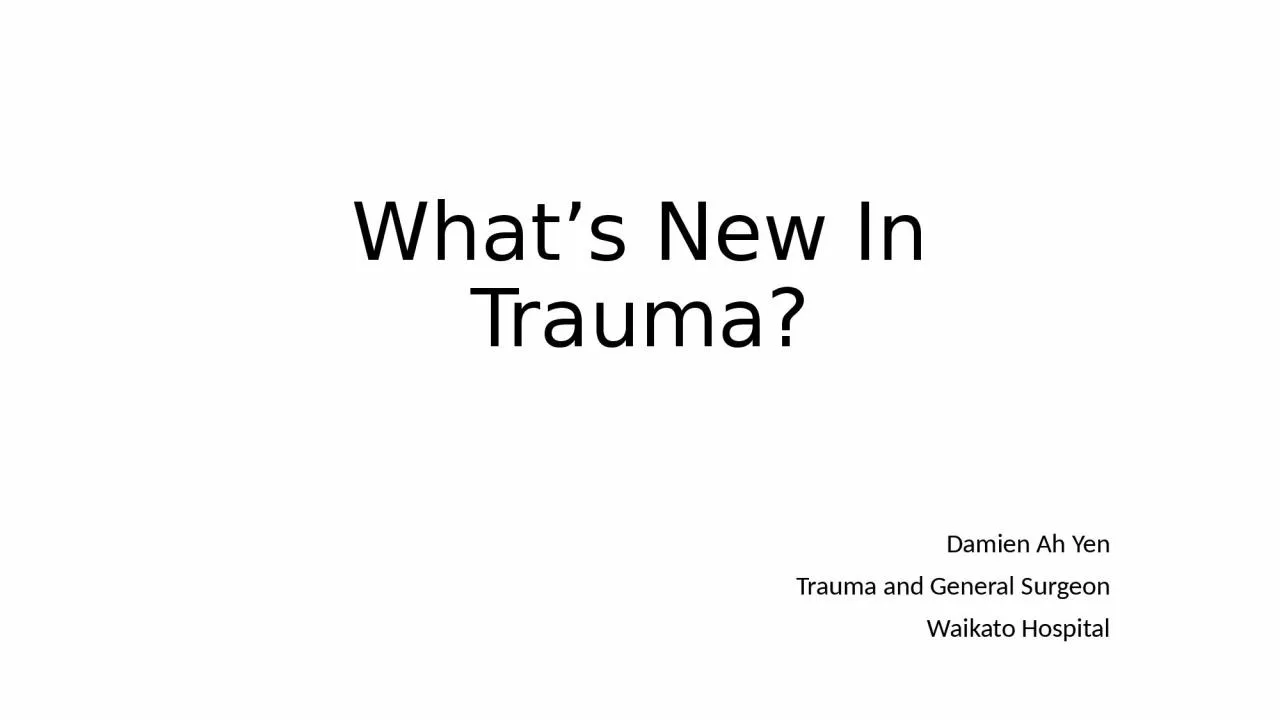

Yen Trauma and General Surgeon Waikato Hospital Whats New Little progress in Operative M anagement Progress Non Operative Management NOM Sometimes LESS surgery is MORE Angioembolization ID: 1047892
Download Presentation The PPT/PDF document "What’s New In Trauma? Damien Ah" is the property of its rightful owner. Permission is granted to download and print the materials on this web site for personal, non-commercial use only, and to display it on your personal computer provided you do not modify the materials and that you retain all copyright notices contained in the materials. By downloading content from our website, you accept the terms of this agreement.
1. What’s New In Trauma?Damien Ah YenTrauma and General SurgeonWaikato Hospital
2. What’s New?Little progress in Operative ManagementProgress Non Operative Management (NOM)Sometimes LESS surgery is MOREAngioembolization Selective NOM of penetrating abdominal injury With some exceptions…Rib Fixation
3. Rise of AngioembolizationEndovascular techniques used in trauma 1990sAdjunct of Non-Operative Management (NOM)From paediatric NOM experiencePrinciplesGel foam vs CoilsSelective vs Non-selectiveWhat types of injuries?Solid Organ InjuriesSpleenLiverKidneysPelvic fractures with vascular injury
4. AngioembolizationSpleenWho?“Stable patients” Transiently responsive?AAST Grade ≥ 4Contrast BlushArterial InjuryHemoperitoneumEfficacyImproves success of NOM up to 97% in the high grade injuriesMajor complications – 9% re-bleed or major infarction requiring splenectomy
5. AngioembolizationHepatic InjuriesWho? Stable patientsNo consensusContrast blushHigh grade injury (AAST ≥ 4)Unstable patient: Operative adjunctHepatic arterial bleed Efficacy93% effective in haemorrhage controlComplications (11%)Liver and gallbladder necrosis (majority)Bile leakLiver failure
6. AngioembolizationRenalWho?No consensusStable patientsAAST Grade ≥ 4Extravasation of contrast or arterial injuryPeri-renal hematoma rim ≥ 3.5cmEfficacyRe-intervention rate 83%AE failure rate 27%
7. Angioembolization Pelvic haemorrhage associated with an unstable pelvic fractureMortality up to 33% - polytrauma with pelvic ring fracturesWho? Haemodynamically unstable CT confirmed bleed Contrast blush?EfficacyOne series report 0% mortality in AE group vs 20% in the non-AEMorbidity associated with delay to AE ARDS, transfusion requirement, MOFComplications Access site (up to 9%)Nephropathy (24%)Claudication, skin necrosis, erectile dysfunction (rare)
8. Selective NOM of Low Velocity Penetrating Abdominal Injury
9. HistoryMandatory Exploratory Laparotomy: ‘standard of care’ until 1960sUp to 45% are non-therapeutic20% complicationsSelective Non-Operative ManagementThere is a role of selective approachDiagnostic accuracy of various modalities is variable Other factors add to the complexityResource constraintsLocal expertise and team infrastructureVolume
10. SelectionClinicalAssessable Generalised peritonism, evisceration, and instability explorationImagingUSSCTInterventional (diagnostic +/- therapeutic)Local Wound ExplorationLaparoscopy
11. AlgorithmsSeveral algorithms All reduce non-therapeutic laparotomiesCombination of modalities mentioned beforePrinciplesSelection of those at ‘low risk’AssessableNo peritonism, no evisceration, haemodynamically stable and normal CTActive observation (serial exams, blood tests, regular observations) of those for NOMAccess to OT with experienced operators
12. Algorithm
13. Thoracoabdominal woundsRisk for diaphragmatic injuriesLow threshold for laparoscopyCT is not very good at excluding diaphragm injury
14. Role of Rib FixationRib fractures are commonRib fractures increased morbidity and mortalityRisk worsened by age and other co-morbiditiesMultiple aspects of “bundled care”Identification of ‘at risk patients’Multimodal analgesiaPulmonary HygieneOPERATIVE INTERVENTION
15. Role of Rib FixationBeen around a while – dates back 1950sDifferent fixation devicesGenerally in and out of favour1970s benefit in the flail chestCurrently there is increasing interest in selected cases
16. Role of FixationWho? De Moya et al, 2017
17. Role of Rib FixationBenefitPneumonia reductionReduction of ICU stayReduced tracheostomy ratesEarlier return to work
18. SummaryAngioembolization is an adjunct to NOM of solid organ injuries and it is the standard of care for haemorrhage associated with pelvic fracturesConsider NOM for stab wounds to the abdomen in the absence of peritoneal signs and haemodynamic instabilitySelect those who are suitable for this approachCT is useful in stratifying riskLaparoscopy is safe in experienced hands to explore the abdomenLow threshold for a laparotomyChest injury management is multi-modal and multidisciplinaryIdentify the ‘high risk’Provide adequate analgesiaLook out for those who may benefit from rib fixation